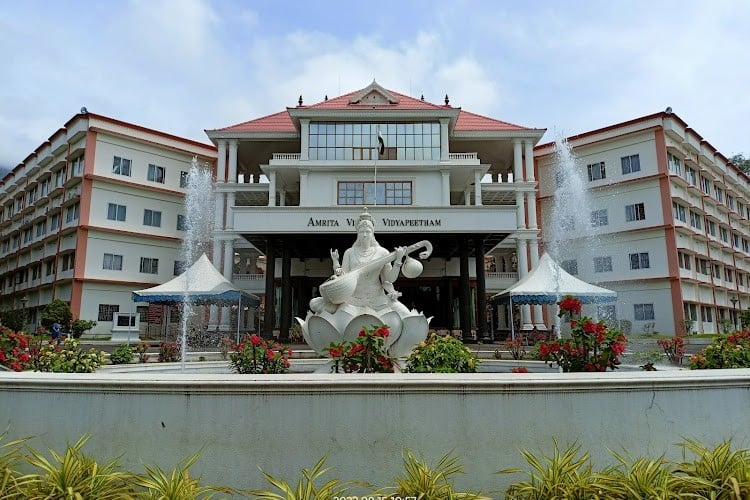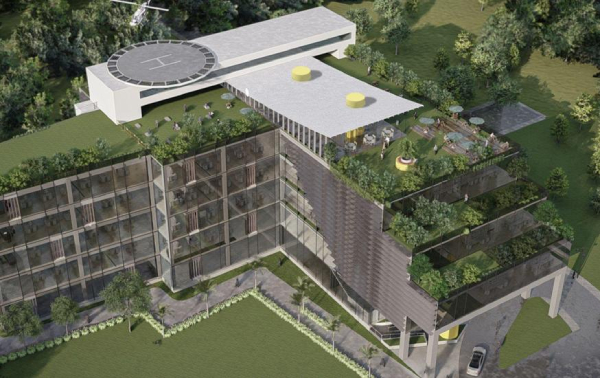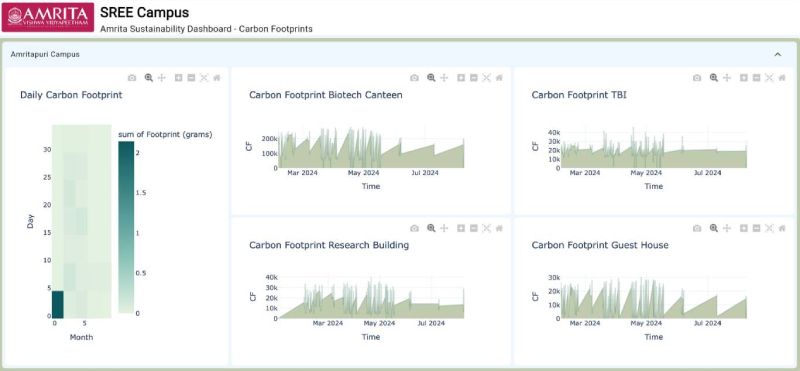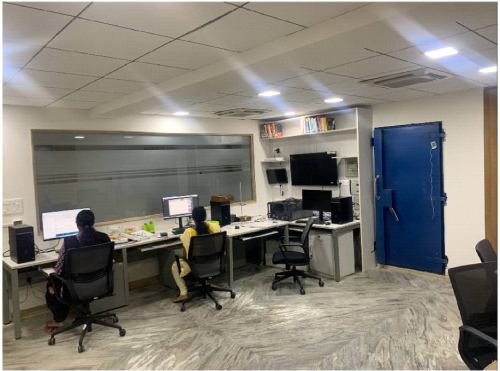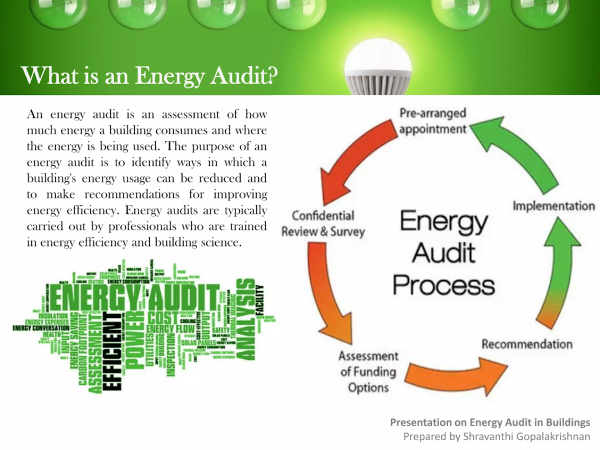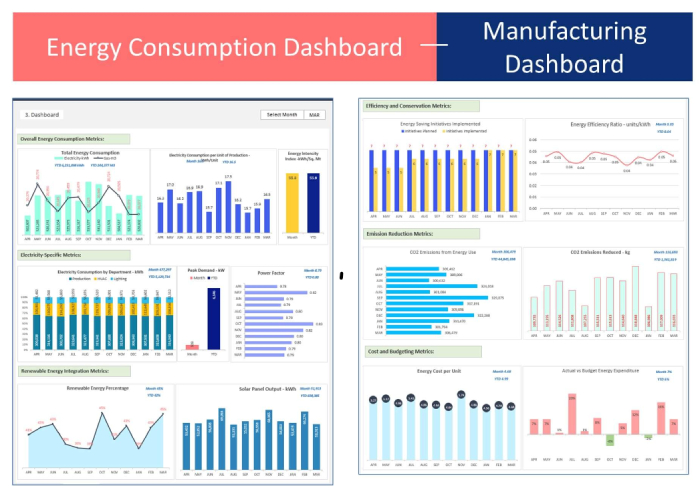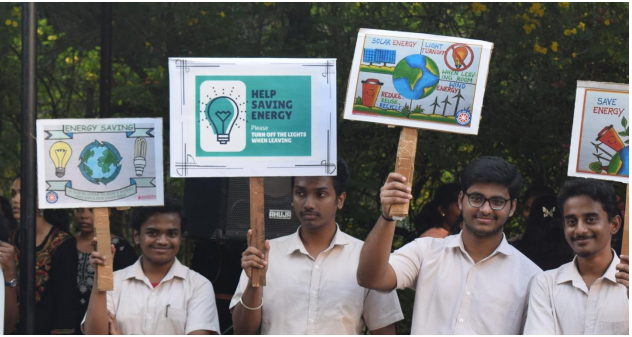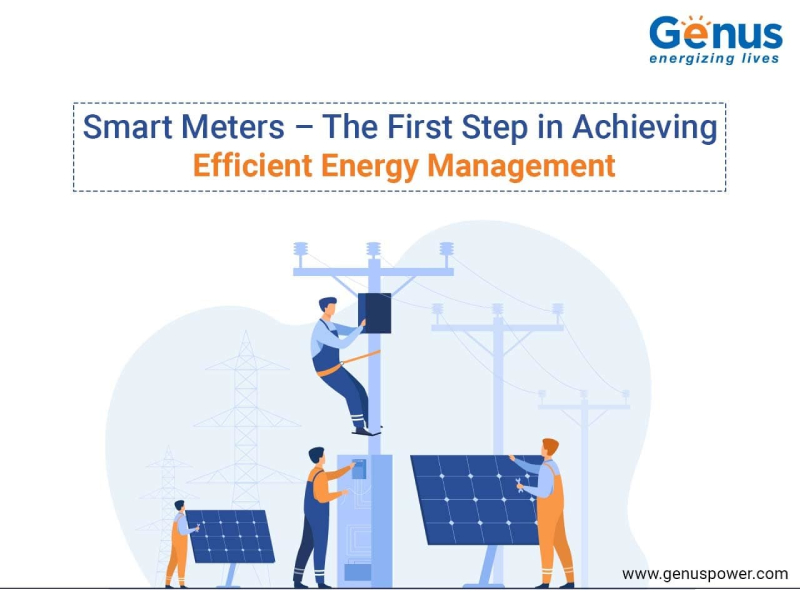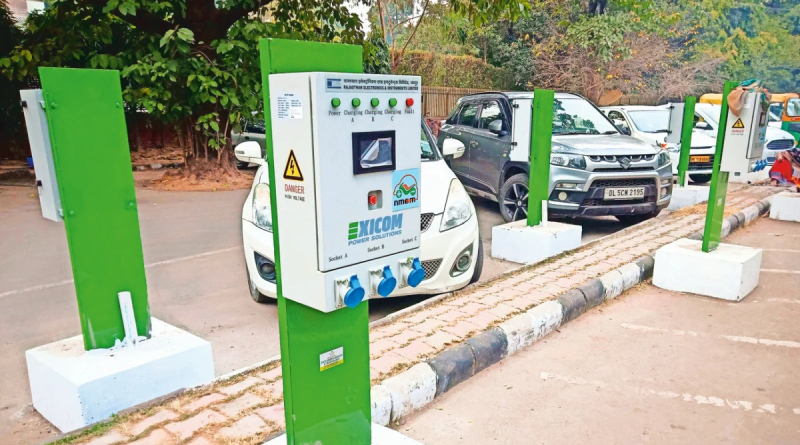Energy Efficiency Plan at Amrita Vishwa Vidyapeetham
Amrita Vishwa Vidyapeetham Coimbatore campus main building with Saraswati statue and fountains
Amrita Vishwa Vidyapeetham has implemented a comprehensive and robust Energy Efficiency Plan designed to reduce overall energy consumption, promote sustainability, and create a climate-positive campus environment. Inspired by the vision of Chancellor Sri Mata Amritanandamayi Devi to minimize energy consumption and foster a greener lifestyle, the university has achieved remarkable success with 32.4% energy cost savings and a 90% energy efficiency rating in its latest energy audit.
Links:
Energy Efficiency Plan at Amrita Vishwa Vidyapeetham
Comparing conventional buildings with green buildings to emphasize the need for sustainable, eco-friendly campus environments.
The university’s energy efficiency initiatives are governed by the comprehensive “Sustainable Campus Policy” formulated in 2020 and updated on November 11, 2023. This policy framework includes a dedicated Sustainable Energy Management Policy that drives all energy-related initiatives across campuses. The policy ensures rigorous assessment of all campuses against outlined goals, fostering a self-driven commitment to efficient and sustainable use of natural resources while minimizing environmental impact.
Link: https://www.amrita.edu/unsdg-sustainable-campus-policy2023/
Energy Efficiency and Sustainability Milestones
The university has achieved significant milestones in 2023:
- Real-Time Energy Management: An energy management system ensures continuous monitoring and control of energy usage
- Energy-Efficient Upgrades: Inefficient appliances and systems replaced with high-efficiency alternatives to optimize energy use
- Sensor-Based Automation: Automated systems utilize real-time occupancy and environmental data to manage workspace energy consumption efficiently
- Temperature Control: Indoor temperature maintained at 24°C, following Bureau of Energy Efficiency (BEE) recommendations
- Heat Recovery Integration: Heat generated by air conditioning systems repurposed to boil water for hot water circulation within buildings
- Clean Energy Surplus: Campus produces 5.24% more clean energy than its total energy demand
- BEE Standards Compliance: 100% compliance with BEE standards across all buildings
- Energy Audit Excellence: Achieved 90% energy efficiency rating in the latest energy audit
- Green Building Accreditations: Earned IGBC Platinum certification and LEED Gold certification for sustainable infrastructure
Links:
Comprehensive Energy Efficiency Initiatives
Workers conducting an energy audit inspection on an HVAC unit to promote energy efficiency.
Diagram and explanation of the energy audit process for buildings to improve efficiency.
A thorough energy audit has been conducted to identify areas of high energy consumption and potential energy-saving opportunities. This comprehensive assessment serves as a baseline for measuring progress and guides the implementation of energy-saving measures.
Energy Audit Methodology:
- Energy Audits and Inspections: Thorough audits conducted across academic buildings, dormitories, labs, and common areas to understand energy consumption patterns
- Data Monitoring and Analysis: Smart energy meters and sensors installed in high-consumption zones to collect real-time data
- Engagement with Stakeholders: Collaboration with students, faculty, and maintenance staff to identify overlooked areas of wastage
Amrita Vishwa Vidyapeetham utilizes third-party agencies to perform multi-campus energy, green, and other quality audits to conserve nature and efficiently utilize natural resources.
Links:
Amrita University hallway showcasing LED lighting installations for energy efficiency across campus.
The university has undertaken extensive lighting system upgrades:
Highlights:
- 1,200 LED replacements in old buildings (2023)
- 1,000 LED lights in newly built spaces
- 100% adoption of sensor-based workspace automation by turning off lights in unused rooms and corridors
- Motion sensors and timers installed in common areas
Traditional lighting fixtures have been replaced with energy-efficient LED lights throughout the campus, significantly reducing energy consumption and maintenance costs while extending the lifespan of lighting systems.
Expected Outcome: 40% reduction in lighting energy use
Links:
Building automation system components for HVAC control and energy management.
The university is committed to maintaining and optimizing heating, ventilation, and air conditioning (HVAC) systems for maximum energy efficiency:
- 100% of buildings have HVAC systems fully meeting ASHRAE 62.1-2007 ventilation standards
- Energy-efficient HVAC systems with Variable Frequency Drives (VFDs) installed
- Regular maintenance including cleaning and replacing air filters, sealing ductwork, and installing programmable thermostats
- All air conditioning systems programmed to maintain 24°C indoor temperature in compliance with BEE standards
- Heat recovery integration: Heat generated by air conditioning systems repurposed to boil water
Expected Outcome: 25% reduction in HVAC energy usage
Links:
Energy and manufacturing dashboards showing comprehensive metrics for monitoring energy consumption, efficiency, conservation, and emissions over time.
Building automation systems (BAS) have been installed to monitor and control energy usage within buildings. These systems optimize energy consumption by adjusting lighting, HVAC, and other systems based on:
- Occupancy levels
- Time schedules
- Environmental conditions
Building Energy Monitoring and Management System:
- Real-time insights into energy consumption patterns
- Visualization of current usage and historical trends
- Calculation of key performance indicators: Energy Use Intensity (EUI) and Power Usage Effectiveness (PUE)
- Carbon footprint tracking
- Alert generation for anomalies or potential issues
- Remote access and control of system settings
Achievement: Annual energy saving of 379,200 kWh, corresponding to a reduction of 311 metric tons of CO₂ emissions per year
Links:
Participants at Amrita University promoting National Energy Conservation Day and energy-saving awareness.
Amrita Vishwa Vidyapeetham actively raises awareness among students, faculty, and staff about the importance of energy conservation. Energy-saving practices actively encouraged include:
- Turning off lights and equipment when not in use
- Utilizing natural lighting
- Enabling power-saving modes on devices
Energy Awareness Programs:
- Campus-wide awareness campaign to educate students and staff on energy-saving practices
- Expected Outcome: 10-15% overall reduction in energy wastage due to behavioral changes
Links:
The university is improving insulation in buildings to minimize heat transfer and reduce the workload on HVAC systems:
- Baseline 2014: 7% of buildings were insulated
- Baseline 2024: 58% of buildings are insulated
- Air leaks around windows, doors, and other openings are being sealed to prevent energy loss
- 35% retrofitting with Double Glazing Units covering 12,000 window panes
Links:
Solar panels installed on a rooftop at Amrita University campus generating renewable energy for higher energy efficiency.
solar-panel-installation-im
Solar panel installation for renewable energy on a campus rooftop, supporting carbon management efforts.
Amrita Vishwa Vidyapeetham is actively exploring and implementing renewable energy sources on campus:
- Solar panel capacity: 4 MW generating 567,228 kWh annually
- Campus produces 5.24% more clean energy than its total energy demand
- 306 kWp rooftop solar PV panels on large academic buildings
- Solar water heaters installed; 50% of hot water needs met by waste heat recovery from air conditioners
- 100% renewable energy by 2035 commitment
- 5 EV charging stations powered by solar energy
- 3 solar-powered mobile telemedicine units
Links:
Outdated and inefficient equipment and appliances are being replaced with energy-efficient models:
- Baseline 2014: 40% CRT Monitors, 60% LCD Monitors, 100% Hard Disk Drives
- Baseline 2024: 100% LED Monitors, 80% Solid-State Drives, integrated with low-power processors
- Computers, printers, refrigerators, and other electrical devices prioritized with energy-efficient labels and ratings
- Usage of 5-star rating equipment such as Solar Geysers and LED lamps promoted
Links:
Illustration showing smart meters and solar panels as key components for efficient energy management.
IoT smart metering facilitates efficient energy management through data transmission, anomaly detection, and remote monitoring.
A real-time monitoring system has been implemented to track energy consumption:
- Energy usage data prominently displayed across campus to create awareness and encourage energy-saving behaviors
- Regular analysis of data helps identify trends, anomalies, and areas for further improvement
- Smart meters and real-time energy monitoring systems installed
- Expected Outcome: Data-driven insights for continuous energy optimization
Links:
Electric vehicle charging station with reserved parking sign on a campus-like setting.
The university actively encourages sustainable transportation options to minimize energy consumption from commuting and campus transportation:
- 60% increase in electric shuttle vehicles
- 40% increase in CNG-powered vehicles
- 45% of car fleet based on electric vehicles or CNG
- 5 EV charging infrastructure on campus
Links:
Lorem ipsum dolor sit amet, consectetur adipiscing elit. Ut elit tellus, luctus nec ullamcorper mattis, pulvinar dapibus leo.
Lorem ipsum dolor sit amet, consectetur adipiscing elit. Ut elit tellus, luctus nec ullamcorper mattis, pulvinar dapibus leo.
Energy Efficiency Standards for New Buildings and Renovations
Aerial view of an academic building at Amrita Vishwa Vidyapeetham campus in Coimbatore with surrounding greenery and hills.
All new buildings and major renovations at Amrita adhere to the Energy-Efficient Building Policy, ensuring the highest energy efficiency standards:
Key Policy Elements:
- Sustainable design principles incorporating energy-efficient systems, sustainable materials, and passive design strategies
- Buildings designed to maximize energy efficiency utilizing renewable energy sources, efficient insulation, and energy-saving technologies such as LED lighting, smart HVAC systems, and energy management systems
- Ready-mixed concrete used in building construction to reduce water demand
- Water-saving technologies including low-flow fixtures, rainwater harvesting systems, and wastewater recycling
Link: https://www.amrita.edu/energy-efficiency-standards-for-renovations-and-new-builds/
Collaboration and Partnerships
Amrita Vishwa Vidyapeetham actively collaborates with energy utility companies, government agencies, and sustainability organizations to access resources, expertise, and funding opportunities for energy efficiency projects. The university actively participates in energy-saving initiatives and programs at regional and national levels.
Link: https://www.amrita.edu/unsdg/sdg7/plan-to-reduce-energy-consumption/
Key Energy Reduction Achievements
The university’s comprehensive energy efficiency plan has yielded impressive results:
- 32.4% energy cost savings achieved
- 90% energy efficiency rating in latest energy audit
- 100% compliance with BEE standards
- 5.24% excess generation of clean energy beyond total energy demand
- 30% reduction in grid dependency by 2025
- 379,200 kWh annual energy saving through Building Energy Monitoring and Management System
- 311 metric tons of CO₂ emissions reduced per year through building automation
- 40% expected reduction in lighting energy use
- 25% expected reduction in HVAC energy usage
- 10-15% overall reduction in energy wastage through behavioral changes
Links:
Monitoring and Continuous Improvement
Energy monitoring is a crucial tool in the university’s sustainability efforts. By tracking energy use, the university gains insights into carbon emissions and identifies areas of high consumption for targeted improvement. This helps the institution reduce its environmental impact and contribute to a more sustainable future.
The university implements:
- Regular energy audits and assessments
- Continuous monitoring through smart systems
- Data-driven decision making
- Stakeholder engagement and feedback
- Phased implementation of improvements
Link: https://www.amrita.edu/project/sustainable-campus-towards-net-zero-carbon-from-energy/
Research and Innovation
The university has undertaken extensive in-house research to advance energy efficiency through collaborative efforts across multiple departments including Electrical and Electronics Engineering, Civil Engineering, Chemical Engineering and Materials Science, and the School for Sustainable Futures. Research areas include:
- Lighting efficiency
- HVAC optimization
- Computer labs and electronics
- Transportation solutions
- Water heating systems
- Building design
- Renewable energy integration
- Awareness and automation
The School for Sustainable Futures focuses on smart grids, energy-efficient IoT frameworks for energy management, sustainable water-energy nexus solutions, and development of hybrid renewable energy systems.
Links:
Recognition and Certification
Amrita University receives IGBC Green Campus Platinum certification for sustainability efforts.
The university’s energy efficiency efforts have earned prestigious recognition:
- IGBC Platinum certification (November 2023)
- LEED Gold certification for sustainable infrastructure
- Best Green Institution Award for outstanding contributions to sustainable practices
- Top 50 global position in THE Impact Rankings 2025
- Ranked 1st in India and 41st globally in sustainable development impact
Links:
Through this comprehensive and multi-faceted Energy Efficiency Plan, Amrita Vishwa Vidyapeetham demonstrates how educational institutions can lead the transition toward sustainable energy consumption, achieving substantial cost savings while fulfilling environmental responsibilities and inspiring broader community action toward a climate-positive future.
- https://www.amrita.edu/unsdg-25/sdg7/upgrade-buildings/
- https://www.amrita.edu/unsdg-25/sdg7/plan-to-reduce-energy/
- https://www.amrita.edu/unsdg-sustainable-campus-policy2023/
- https://www.amrita.edu/energy-efficiency-standards-for-renovations-and-new-builds/
- https://www.amrita.edu/unsdg-25/sdg13/low-carbon-energy-tracking/
- https://www.amrita.edu/news/amrita-vishwa-vidyapeetham-coimbatore-campus-awarded-prestigious-platinum-certification/
- https://www.amrita.edu/unsdg/sdg7/plan-to-reduce-energy-consumption/
- https://www.amrita.edu/unsdg-25/sdg7/energy-wastage-identification/
- https://www.amrita.edu/quality-audits/
- https://www.amrita.edu/unsdg-25/sdg7/carbon-reduction-and-emission/
- https://www.amrita.edu/unsdg-25/sdg7/renewable-energy-pledge/
- https://www.amrita.edu/project/sustainable-campus-towards-net-zero-carbon-from-energy/
- https://www.amrita.edu/school/sustainable-futures/afforadable-and-clean-energy/
- https://www.facebook.com/amritapuricampus/posts/amrita-vishwa-vidyapeetham-has-been-honoured-with-the-best-green-institution-awa/1109590484536656/
- https://medicircle.in/amrita-vishwa-vidyapeetham-among-worlds-top-50-in-the-impact-rankings-2025
- https://www.facebook.com/AmritaUniversity/videos/amrita-vishwa-vidyapeetham-has-been-ranked-1st-in-india-and-41st-globally-in-the/1424934542153748/
- https://www.amrita.edu/unsdg/sdg6/policy-divestment-from-carbon-intensive-energy-industries-policy/
- https://www.amrita.edu/research/thematic-areas/energy-environment-and-sustainability/power-and-energy/
- https://www.linkedin.com/posts/amrita-university-alumni_celebrating-innovation-excellence-from-activity-7305129423341600769-wAfB
- https://www.amrita.edu/research/thematic-areas/energy-environment-and-sustainability/sustainable-environment/
- https://cioms.ch/wp-content/uploads/2019/10/3.-Being-Sustainable-Amrita-University-Case-Studies.-Shyam-Diwakar.-RIBEF-CIOMS_Oct8_Amrita.pdf
- https://www.amrita.edu/course/sustainable-and-renewable-energy-technology/
- https://www.facebook.com/photo.php?fbid=1213570164107993&id=100063650634427&set=a.552408293557520
- https://pubmed.ncbi.nlm.nih.gov/40269233/
- https://c20.amma.org/src-wg/working-groups/
- https://www.facebook.com/AmritaUniversity/posts/deadline-extended-submit-by-30th-june-2025the-international-conference-on-sustai/1116845110475134/
- https://hcaschennai.edu.in/wp-content/uploads/2025/09/7-1-6-A.pdf
- https://www.amrita.edu/campus/amritapuri/disclosures/financial-statements-audit-report/
- https://www.amrita.edu/unsdg/sdg7/policy-development-for-clean-energy-tech/
- https://www.sciencedirect.com/science/article/abs/pii/S0301421515301762
- https://www.linkedin.com/posts/fcf-india_icsrf25-carbonneutral-carbonmarkets-activity-7366087614443028480-9aj6
- https://ammachilabs.org/amrita-leaders-highlight-education-for-sustainability-at-icsrf-2025/




